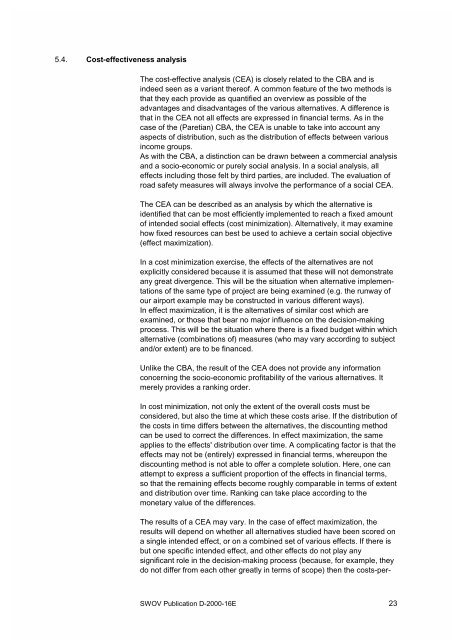Economic evaluation of road safety measures - Swov
Economic evaluation of road safety measures - Swov
Economic evaluation of road safety measures - Swov
You also want an ePaper? Increase the reach of your titles
YUMPU automatically turns print PDFs into web optimized ePapers that Google loves.
5.4. Cost-effectiveness analysis<br />
The cost-effective analysis (CEA) is closely related to the CBA and is<br />
indeed seen as a variant there<strong>of</strong>. A common feature <strong>of</strong> the two methods is<br />
that they each provide as quantified an overview as possible <strong>of</strong> the<br />
advantages and disadvantages <strong>of</strong> the various alternatives. A difference is<br />
that in the CEA not all effects are expressed in financial terms. As in the<br />
case <strong>of</strong> the (Paretian) CBA, the CEA is unable to take into account any<br />
aspects <strong>of</strong> distribution, such as the distribution <strong>of</strong> effects between various<br />
income groups.<br />
As with the CBA, a distinction can be drawn between a commercial analysis<br />
and a socio-economic or purely social analysis. In a social analysis, all<br />
effects including those felt by third parties, are included. The <strong>evaluation</strong> <strong>of</strong><br />
<strong>road</strong> <strong>safety</strong> <strong>measures</strong> will always involve the performance <strong>of</strong> a social CEA.<br />
The CEA can be described as an analysis by which the alternative is<br />
identified that can be most efficiently implemented to reach a fixed amount<br />
<strong>of</strong> intended social effects (cost minimization). Alternatively, it may examine<br />
how fixed resources can best be used to achieve a certain social objective<br />
(effect maximization).<br />
In a cost minimization exercise, the effects <strong>of</strong> the alternatives are not<br />
explicitly considered because it is assumed that these will not demonstrate<br />
any great divergence. This will be the situation when alternative implementations<br />
<strong>of</strong> the same type <strong>of</strong> project are being examined (e.g. the runway <strong>of</strong><br />
our airport example may be constructed in various different ways).<br />
In effect maximization, it is the alternatives <strong>of</strong> similar cost which are<br />
examined, or those that bear no major influence on the decision-making<br />
process. This will be the situation where there is a fixed budget within which<br />
alternative (combinations <strong>of</strong>) <strong>measures</strong> (who may vary according to subject<br />
and/or extent) are to be financed.<br />
Unlike the CBA, the result <strong>of</strong> the CEA does not provide any information<br />
concerning the socio-economic pr<strong>of</strong>itability <strong>of</strong> the various alternatives. It<br />
merely provides a ranking order.<br />
In cost minimization, not only the extent <strong>of</strong> the overall costs must be<br />
considered, but also the time at which these costs arise. If the distribution <strong>of</strong><br />
the costs in time differs between the alternatives, the discounting method<br />
can be used to correct the differences. In effect maximization, the same<br />
applies to the effects' distribution over time. A complicating factor is that the<br />
effects may not be (entirely) expressed in financial terms, whereupon the<br />
discounting method is not able to <strong>of</strong>fer a complete solution. Here, one can<br />
attempt to express a sufficient proportion <strong>of</strong> the effects in financial terms,<br />
so that the remaining effects become roughly comparable in terms <strong>of</strong> extent<br />
and distribution over time. Ranking can take place according to the<br />
monetary value <strong>of</strong> the differences.<br />
The results <strong>of</strong> a CEA may vary. In the case <strong>of</strong> effect maximization, the<br />
results will depend on whether all alternatives studied have been scored on<br />
a single intended effect, or on a combined set <strong>of</strong> various effects. If there is<br />
but one specific intended effect, and other effects do not play any<br />
significant role in the decision-making process (because, for example, they<br />
do not differ from each other greatly in terms <strong>of</strong> scope) then the costs-per-<br />
SWOV Publication D-2000-16E 23
















